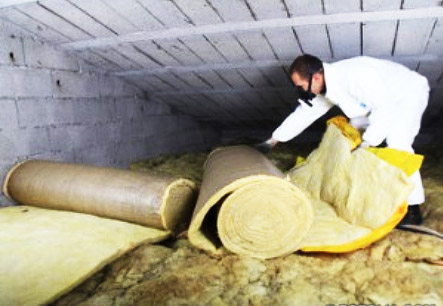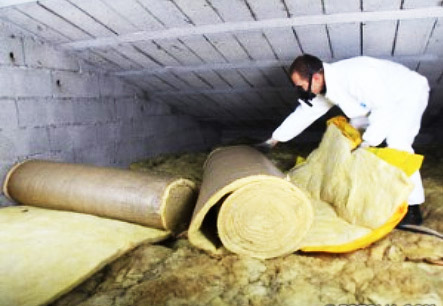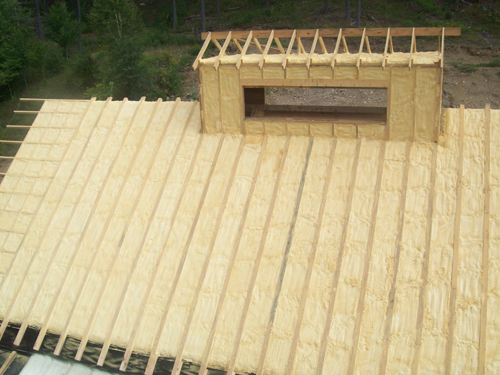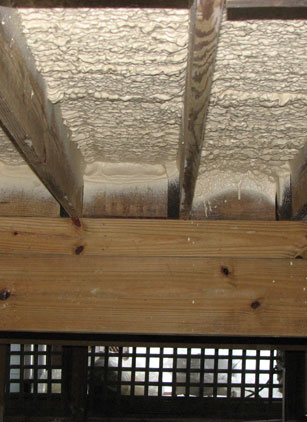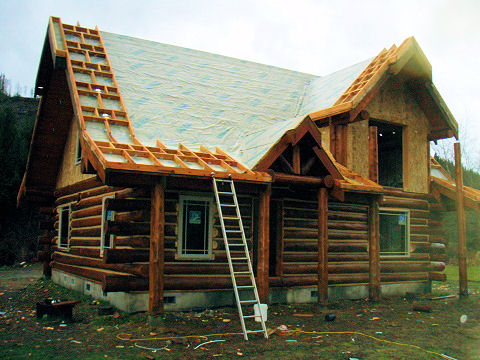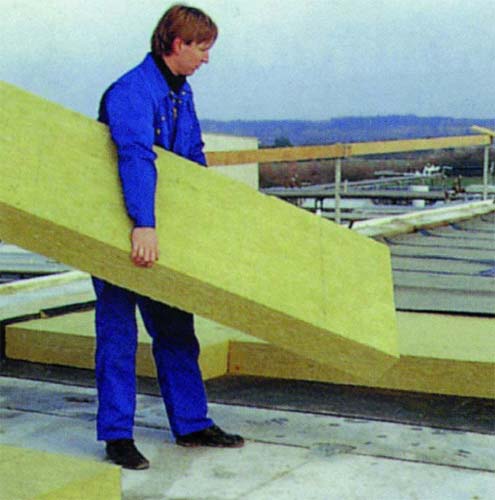It is very important when building a home to make it the most warm and comfortable, so the use of special insulation is simply necessary.
Content
The insulation for the roof is used in several cases:
- In order to landscaping the residential premises in the attic;
- When to create thermal insulation of the overlap itself.
As for the isolation of the overlap, it is equipped to preserve heat in the construction itself. The insulation layer protects the ceiling from the frozen, and also does not allow the warm air to penetrate the house into another space.
Thanks to the creation of a warm ceiling, you will significantly save on gas and electricity consisting on heating at home. And since all the attic rooms are divided into 2 types - residential and non-residential, then the type of thermal insulation building material is chosen according to their destination.
If attic is planned in the attic, then not only overlapping, but also walls, ceiling follows.
Modern types of insulation:
1. Mineral Wat.
It has a variety of fiber structure (vertically-layered, corrugated, spatial, horizontal layered). This material is not afraid of dampness, it is able to withstand high temperatures, is an excellent soundproofer and does not affect chemicals.
2. Glassovat
According to the properties similar to Minvate, however, has a lower thermal storge. It has thermal insulating and noise absorbing characteristics, not crushed with long exploitation, does not absorb moisture and has increased frost resistance.
3. Polyurethan
It is a gas-filled plastic, which is capable of keeping heat, not to miss steam and moisture. Such material is quite easy and durable.
4. Foamed expanded polystyrene
This is a fairly easy building material, which refers to the class of foams. It is often used as a heater for a flat roof. It has not very big weight and is durable.
5. Shelot (Equata)
It is a type of minvati, which is made from the melt of domain slags.
What insulation is better for roofing?
Before choosing one or another insulation, it is necessary to pay attention to its inhabitual and future assignment of the attic room.
Characteristics with which he must possess:
- be eco-friendly
- should not absorb moisture and be frostable;
- If you have a metal roof, then you need to choose a heater, having noise absorbing properties;
- It must be fireproof;
- its service life must be at least 50 years;
- Must have a low weight, etc.
Recommendations:
1. Such a feature of the insulation as form stability means that it should be perfectly in contact with all the elements of the roof without gaps. Therefore, it is not recommended to choose a heater for the pitched roof, which has high density.
2. A loose fit of the insulation may cause the formation of the bridges of cold air and the occurrence of condensation. Even among some types of Minvati, building materials with high density must be avoided.
3. Materials based on minvati and foam plastic with high density is better to use as a flat roof insulation.
The thickness of the insulation for the roof and its weight
In order to calculate the thickness of the heat-insulating building material, it is necessary to be based on special building standards and formulas. The calculation should include the type of material and the climatic belt of the insulated structure. For each climatic zone, there are own thermal transmission resistance coefficients showing the possibility of material to store heat. Knowing it and thermal conductivity of the insulation itself, one can calculate the optimal thickness.
Also, acquiring the insulation for the roof, pay special attention to its weight. In this case, many prefer glaze.
The difference between insulation, intended for the roof, from other thermal insulation building materials
The thermal insulation of the roof, which has a flat type - a rather complicated process. Experts call such insulation "Roofing Pie", since its design consists of several layers:
- Professional flooring or carrier;
- vapor insulating building materials;
- Hydro and thermal insulation layer.
Each layer carries a certain value. So, for example, vaporizolation is paired in order to prevent condensate from entering, which penetrates from the operating room, and the waterproofing layer is used to protect the roofing design from the conjunction.
Insulation, designed for the roof, are characterized by a good indicator of rigidity and strength, because they must withstand global loads. When buying, be sure to look at the compression ratio - than it is less, the better the material.
Requirements that should fit roofing heat-insulating building materials:
- have environmental friendliness;
- have a good level of thermal resistance;
- be able to absorb and retain moisture;
- have a low thermal conductivity;
- have a low compression coefficient;
- To be resistant to mechanical damage.
Heater density for roofing
The density of the roofing heat-insulating building material should not exceed 250 kg / m3. Otherwise, the load on the overlap can increase. At the same time, the more its density, the less heat-conducting characteristics it possesses.
Today, when the roof is insulation, the use of a two-layer system was quite popular: a low density insulation is used as the lower layer, and for the top - more dense stoves.
Modern heaters for roofing
The best insulation for roofs:
1. Insulation for Roofing Knauf
KNAUF produces eco-friendly thermal and acoustic insulation for special ECOSE® Technology. The range also presents mineral wool, glass wool and polystyrene.
The benefits of building materials:
- naturalness;
- ease of use;
- absence of foreign odor;
- Installation separated on 70% less dust;
- have a low weight;
- long keep its shape;
- increase the service life of the roof;
- have high acoustic insulation, water vapor permeability, etc.
In order to avoid heat loss through the roof construction, the company recommends the use of KNAUF brand products KNAUF Insulation Pitched roof. It is a highly effective mineral wool insulation with minimal water absorption.
Construction of this company have different thermal technical parameters, dimensions and izgotalivayutsya in the form of slabs and mats:
- Plate 037 A;
- Roll 037 A;
- Plate 034;
- Thermo Roll 034 A.
Application:
- agro-industrial complex;
- health;
- factories catering;
- industrial, residential and public buildings.
2. Thermal insulation for roofs URSA
URSA - a European manufacturer of thermal insulation roofing materials, which never ceases to improve its products. It produces materials based on extruded polystyrene foam and staple fiber.
The advantages of this product:
- ease of use;
- practicality;
- efficiency;
- environmental friendliness;
- versatility of use;
- resistance to chemical and mechanical action;
- Materials maximum fit snugly to the surface;
- have a low coefficient of thermal conductivity;
- Excellent sound, heat insulation, etc.
species:
- URSA M-15;
- URSA P-15;
- URSA M-11, M-11 (R);
- Pitched roof URSA, Glasswool et al.
3. Insulation for Isover roof
ISOVER pitched roof - it's pretty light and sound insulating panels of mineral wool made of the highest quality on the basis of fiberglass. The material has high moisture resistance and for buildings with complex humidity mode.
Advantages:
- pretty tight to any design configuration;
- does not imply fasteners have been fixed vraspor;
- It is environmentally friendly;
- light and flexible;
- convenient for transportation;
- easy to install;
- durable;
- It has excellent insulation and low thermal conductivity;
- increased moisture resistance;
- reliable sound insulation;
- non-flammable;
- biostoek (rot and the like).
Scope of use Isover materials:
- industrial equipment;
- engineering communications and systems;
- overlaps and floors;
- suspended ceilings, wall cladding, partitions;
- roofs (flat and scanty);
- Facades and walls.
species:
- ISOVER sauna®;
- Isover floating floor;
- ISOVER BETONPLIT®;
- ISOVER KARCAS-M®, KARCAS-P®;
- IsOVER plaster facade®;
- ISOVER VENTFASADNIS®;
- Isover Ventfasadst®;
- ISOVER RECORDING®;
- Isover scope roof®;
- IsOnder Classic®.
Using Isover Scope Roofing:
- noise and thermal insulation of plants from a metal of the element assembly;
- Soundproofing partitions;
- sound and thermal insulation of inter-storey floors;
- sound and thermal insulation of lagham floors;
- noise and thermal insulation of walls in cottage and low-rise construction;
- Sound and thermal insulation of the attic and all types of scope roofs.

